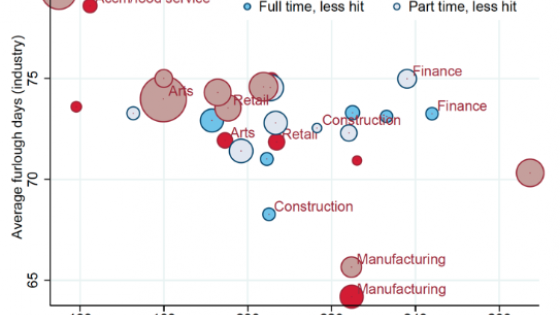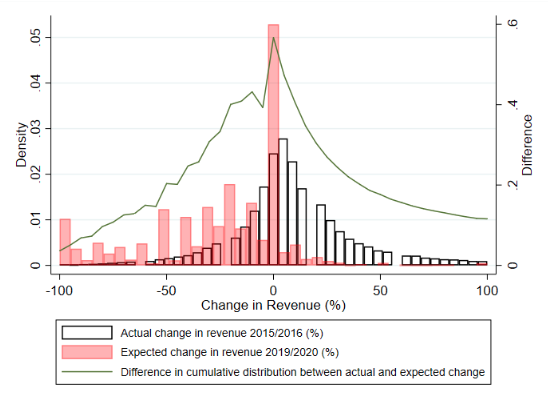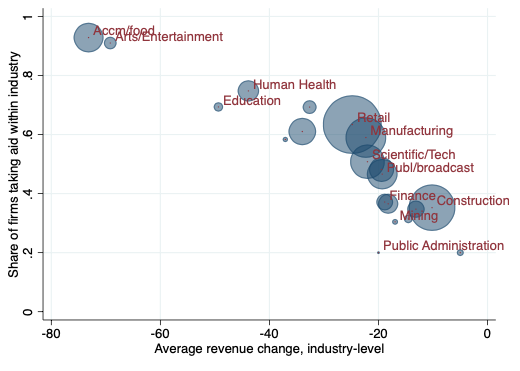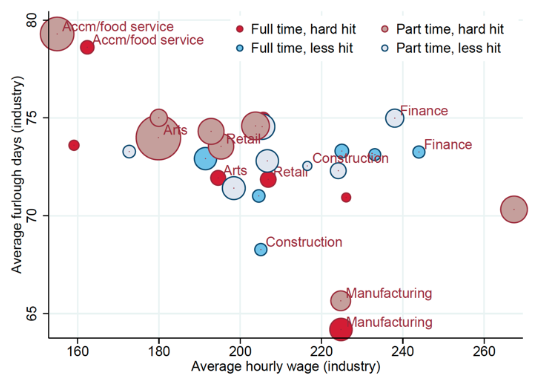The COVID-19 pandemic has caused – and continues to cause – widespread economic havoc to lives and livelihoods throughout the world. Social distancing measures imposed in countries required all but the most essential employees to either work from home, or not to work. Governments worldwide have sought to help businesses cope in various ways by offering employment subsidies, cost subsidies, and tax payment delays.
As a result, important questions are being raised about the impact of such measures on firms, the choices they make regarding aid, and the comparative effectiveness of various policies. Firms and their managers will determine the ultimate allocation of trillions of dollars in aid globally, so studying their choices can reveal which policies are most likely to be effective and help limit wasteful spending. In particular, encouraging firms to preserve employment has been a key component of the policy response early on in the pandemic. This is because preserving job matches may accelerate recovery and also mitigate the long-term ramifications of job loss for workers. Barrero et al. (2020) estimate that 42% of recent layoffs will become permanent job losses, while Montenovo et al. (2020) show that job losses take a greater toll on certain groups – minorities, women, young workers (ages 20-24), and those with high school degrees and some from college.
We also need to better understand where government aid flows, and why. Is help reaching the firms that need it most? Or is it simply flowing to the most powerful? Cororaton and Rosen (2020) report some evidence from the US Paycheck Protection Program showing that while half of public firms were eligible, only 13% ultimately became borrowers. Chetty et al. (2020) further show that the programme had limited impact likely because those who did take up the loans may not have intended to enact layoffs anyway. Indeed, in the wake of negative publicity, some US firms have returned the government aid.
How did the pandemic affect firms?
We explore these issues by asking firms themselves how they were affected both by government measures implemented to halt the spread of the disease, and by those intended to help firms cope (Bennedsen et al. 2020). We surveyed a representative sample of 10,642 firms in Denmark between April and May 2020. The sample covers small, medium, and large firms across all industries. We estimate that the survey respondents represent between 25-40% of the private labour market in Denmark.
We asked firms about pandemic-related disruptions to their normal operations, with a focus on alternative labour arrangements and government aid take-up. We also collect data on baseline firm employment, costs, and liquidity, along with perceptions on the crisis and the recovery period.
The situation in Denmark offers a window into the situation faced by firms in many European and North American countries. As shown by Dingel and Neiman (2020), roughly 40% of workers have jobs that allow them to work from home – a level that is similar to those in other OECD countries. Furthermore, the government’s response in Denmark was very much like that of other European countries, where active labour market policies have played a central role.
The toll of the pandemic on firms
Danish firms report unprecedented declines in revenue in April 2020. Nearly 70% of firms report a revenue decline, with the median firm experiencing a decline of 20% (Figure 1). In nearly all industries, more than half of the firms expected decreases in revenue. In any given year, many firms experience decreases in revenue, including substantial decreases of more than 35%. By comparison to this year, however, only about 6% of firms in 2016 had declines larger than 35%, and roughly 37% had any declines at all.
Figure 1 Distribution of revenue changes in 2020 and 2016
In Denmark, as has been the case worldwide, certain industries were particularly hard hit (Figure 2). Our survey shows average declines in revenue of 73% for firms in accommodation and food services, 69% for arts and entertainment, and 50% in education. Retail and manufacturing were also badly affected, with 70% of firms reporting decline in revenue.
Figure 2 Share of firms taking up aid programmes and change in revenue
The most badly hit sector took up aid
Reassuringly, firms experiencing declines in revenue were the primary takers of government aid. Further, we find a strong relationship between government aid and how firms manage their employment relationships. While firms’ primary response to the crisis was to furlough a large share of their workforce, they report that without government support they would have likely enacted layoffs instead. The average firm that took aid furloughed 30% and laid off only 2% of its workers. Without aid, firms indicate that they would have furloughed closer to 17%, and laid off 25% of the workforce.
The impacts of different aid measures
The government policy aid package in Denmark, like those in many other countries, focused on providing subsidies for retaining employees, propping up businesses with fixed-cost grants, and allowing for deferral in tax obligations. The costs of the aid programmes in Denmark are estimated to be close to 100 billion Danish kroner ($14.7 billion or €13.4 billion). We primarily focused our analysis on the labour-related aid, but also provide some related analysis of the take-up of the other types of aid in the paper. While we find that the most common type of aid package taken up by firms is labour and fiscal related, a non-trivial share of firms also take on aid to cover fixed costs.
The impacts of different aid measures
We find that government aid has a strong impact on reported labour choices (Figure 3). Firms that took up aid report furloughing more and laying off fewer workers than they would have absent government aid. However, this relationship varies with the kind of aid that firms use.
Figure 3 Share of furloughs and layoffs relative to revenue change
We find a strong relationship between taking up labour aid and reporting lower layoffs and more furloughs. For firms taking up cost aid, the relationship is mixed. While it is associated with lower layoffs, lower furloughs are contingent on also taking labour aid. We do not find the same relationship for firms taking up fiscal aid, which is the most expensive aid programme, however, the effect is hard to cleanly identify. We find that neither financial distress nor being in a hard-hit industry is correlated with higher take up of fiscal aide. It is not clear that take-up of fiscal aid is correlated with furloughs. At the same time, it is too early to detect the potential impact on liquidity, costs, and survival – the outcomes that are more likely to be the goal of such fiscal aid subsidies.
Characterising the furloughs
While 242,126 people are registered and receiving government aid under the furlough scheme, the patterns of furlough activity are not uniform. Using government records of all furloughed employees in Denmark under the scheme, we can provide a brief characterisation of the furlough activity across workers and firms. In the entire population of furloughed workers, the median number of furloughed days is 77 (out of a maximum of 90). Non-full-time workers make up 42% of the total furloughed workers, and have a higher average number of days furloughed, at 73 days, relative to full time workers who are furloughed for 65 days on average.
At the firm level, most firms choose to furlough employees for similar amounts of time. At the industry level, Figure 4 summarises the relationship between average furlough days, hourly wage, and revenue shock. The size of the circle indicates the sum of the number of furloughed workers in the industry. Firms in harder hit industries tend to have lower wages, lower incidence of full-time workers, and larger average number of furloughed days (especially for non-full-time workers). Firms in less hard-hit industries furloughed fewer workers but for a similar length of time as other firms.
Figure 4 Characterising the furloughs
Where to go from here
Taken together, the results provide strong evidence of the success of targeted government policy in helping firms stay afloat, and creating incentives for them to retain their employees – thereby reducing the country’s aggregate level of unemployment. The aid policies helped decrease the number of layoffs and increase the number of furloughs. We estimate that the policies helped avoid approximately 81,000 layoffs and instead, created an additional 285,000 furloughs.
We hope these insights may help policymakers better understand the potential effects of policy levers that can be brought to bear at times of such cataclysmic events. Long-term repercussions deserve greater scrutiny as the pandemic plays out, and as recovery efforts begin.
References
Barrero, J M, N Bloom and S J Davis (2020), “Covid-19 is also a reallocation shock”, NBER Working Paper 27137.
Bennedsen, M, B Larsen, I Schmutte and D Scur (2020), "Preserving job matches during the COVID-19 pandemic: Firm-level evidence on the role of government aid", Covid Economics: Vetted and Real-Time Papers 27, 9 May.
Chetty, R, J Friedman, N Hendren and M Stepner (2020), “How did covid-19 and stabilization policies affect spending and employment? A new real-time economic tracker-based on private sector data”, Opportunity Insights Working paper.
Cororaton, A and S Rosen (2020), “Public firm borrowers of the US paycheck protection program”, Covid Economics: Vetted and Real-Time Papers 15, 7 May.
Dingel, J I and B Neiman (2020), “How many jobs can be done at home?” Covid Economics: Vetted and Real-Time Papers 1, 3 April.
Montenovo, L, X Jiang, F L Rojas, I M Schmutte, K I Simon, B A Weinberg and C Wing (2020), “Determinants of disparities in covid-19 job losses”, NBER Working Paper 27132.












